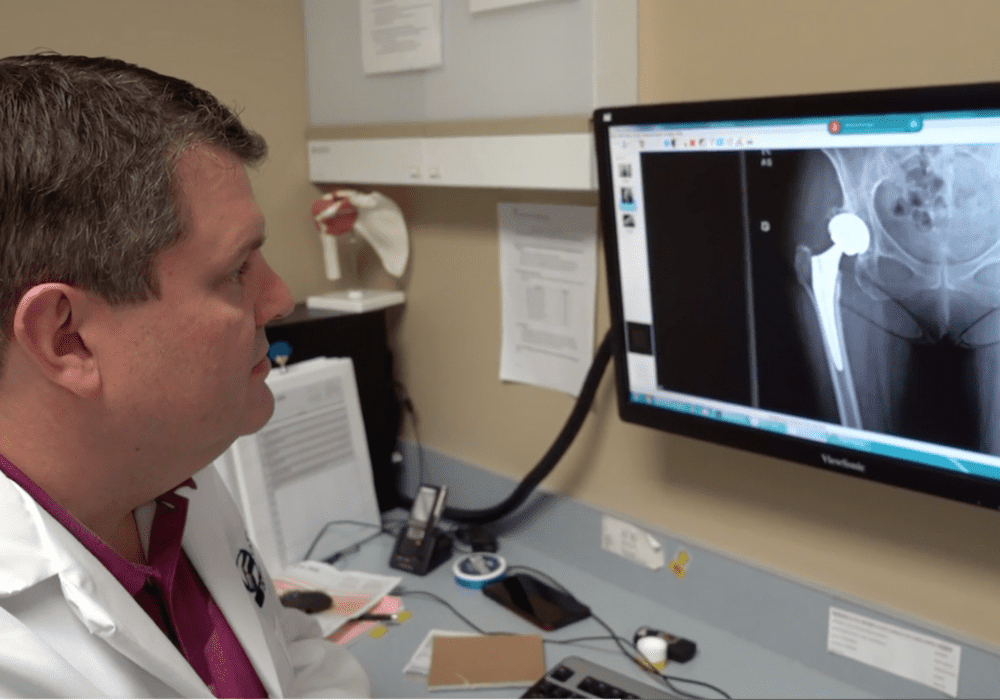Can Outpatient Anterior Approach Total Hip Replacement Surgery Get Patients Home the Same Day?
- What Makes an Anterior Approach Total Hip Replacement Different?
- What is Recovery Like After an Anterior Approach Hip Replacement?
- How Effective is an Anterior Approach Total Hip Replacement?
- About Outpatient Anterior Approach Total Joint Replacement
Megan Lynch will tell you she lived with hip pain for too long. She knew she needed hip replacement surgery, but she was afraid to get it done despite years of nagging pain.
“You know, I was really nervous. I had been putting it off for so long and didn’t want to be out of commission, didn’t want to stay in a hospital,” Lynch says. “Both my parents had hip replacements, and so I saw what they had gone through with a hospital stay and having to go to a rehab center.”
Luckily for Lynch, she didn’t have to deal with either of those challenges because of her outpatient anterior approach total hip replacement procedure with Eric G. Bonenberger, M.D., a board-certified and fellowship-trained orthopaedic surgeon at Orlando Orthopaedic Center specializing in knee, hip and shoulder surgery. Lynch really liked the idea of having a minimally invasive outpatient hip surgery so she could go home the same day.
Lynch believes she chose the right surgeon in Dr. Bonenberger and the right procedure to replace her hip. “It was something that gave me my life back. I was in horrible pain, barely could walk,” she says. “And now, recently after, my quality of life is back to what it was 10 years ago.”
What Makes an Anterior Approach Total Hip Replacement Different?
For an anterior approach total hip replacement, the surgeon makes a small incision on the front of the hip, instead of to the back of the hip with the traditional posterior approach. This smaller incision spares most of the buttocks muscles and tissue surrounding the hip joint, reducing the time needed to complete the surgery and helping minimize the risk of infection in the operating room.
 The smaller incision with the anterior approach offers several benefits for patients:
The smaller incision with the anterior approach offers several benefits for patients:
- Faster recovery times
- Less pain
- Less restriction on movement after surgery
- Increased mobility
- A smaller scar
When using an anterior approach, the surgeon makes an incision much closer to the hip joint than with the posterior approach. This impacts less tissue between the skin and the underlying bony structures.
During the surgery, the soft tissue is handled in such a way that the muscles and the tendons are not detached from the bone. This helps reduce pain and improves recovery time.
Lynch believes the anterior approach made a noticeable difference for her.
Dr. Bonenberger met with Lynch and explained exactly what would happen before, during, and after the minimally invasive outpatient procedure. Lynch recalls she went into the surgery feeling confident she would make a full recovery.
Lynch says, “Dr. Bonenberger put me at ease the first meeting that we had about doing this procedure because his temperament is such that you just feel immediately like everything is going to be ok.”
What is Recovery Like After an Anterior Approach Hip Replacement?
The physician will normally urge a patient to sit up and walk slowly as soon as possible, inside the surgery center, after an anterior approach hip replacement. Movement after the surgery increases blood flow and can reduce the risk of blood clots.
The physical rehabilitation process plays out over several weeks. The care team will introduce physical therapy to strengthen the hip muscles and to improve the range of motion. Therapists will also consider any movement restrictions in the patient’s hip as they make a therapy plan.
During rehabilitation, the patient is working to achieve full balance again and to have muscles and tendons regain flexibility. Most patients will start using a walker right away for the first one to two weeks after the surgery. Many individuals then switch to using a cane for one week to ten days.
Many patients can walk on their own one week after the surgery, and they can often resume their normal activities shortly after that.
Lynch says her anterior approach total hip replacement and Dr. Bonenberger’s care changed her life dramatically.
She says, “When I compare my experience to what other people go through, I can’t even believe it was the same procedure.”
How Effective is an Anterior Approach Total Hip Replacement?

A study published in 2019 in the medical journal The Lancet found 70 percent of total hip replacements lasted 20 years and almost 90 percent lasted 15 years.
Lynch has completed her physical rehabilitation from surgery and is thrilled with the range of motion in her hip. She says her anterior approach total hip replacement at Orlando Orthopaedic Center is helping her to stay active and to spend quality time with her family.
“I really just want to say thank you to Orlando Orthopaedic Center for being such a great, great practice to work with,” Lynch says. “Particularly thank you to Dr. Bonenberger and the whole team for making this a major milestone in my life, something that turned into an incredible, positive experience and gave me my life back. Thank you so much.”
About Outpatient Anterior Approach Total Joint Replacement
Dr Bonenberger is one of Florida’s original anterior approach hip surgeons. He has been performing this technique since 2007. He only utilizes state of the art facilities including Orlando Orthopaedic Outpatient Surgery Center, Dr. P. Phillips Hospital, and Oviedo Medical Center. He is one of only a handful of surgeons in the U.S. certified for all three MAKO platforms – partial knee, total knee, and total hip.
Dr. Bonenberger’s outpatient total joint procedures include:
- Anterior Approach Total Hip Arthroplasty
- Total Knee Replacement
- Partial Knee Replacement
- Total Shoulder Replacement
- Reverse Total Shoulder Replacement
Ideal Candidates for Outpatient Anterior Approach Total Hip or Knee Replacement
- Age usually 70 or less
- BMI 35 or less
- No diabetes or excellent control with AIC 7 or less
- Non-smoker
- No significant cardiopulmonary issues
- Those who don’t meet the criteria can typically be done in the hospital with the same day or next day discharge, but the BMI limit of 35 does apply.


